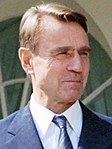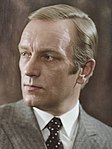1988_Finnish_presidential_election
Presidential elections were held in Finland in 1988.[1] They were the first elections held under a new system. Previously, the public had elected an electoral college that in turn elected the President. For this election, the public directly elected the President on 31 January and 1 February, but also elected an electoral college that would elect the President if no candidate won over 50% of the popular vote.[2] The college was increased in size from 300 to 301 seats to make a tie less likely, though this was still technically possible, as electors could abstain from voting.[2]
The contest's outcome, the re-election of Mauno Koivisto, surprised no one, yet he captured a smaller portion of the direct popular vote than expected—only 48.9 percent,[3] rather than the 60 to 70 percent forecast by opinion polls during 1987. His failure to win more than half of the direct, or popular, vote with an 84 percent turnout meant that Koivisto could claim victory only after he had the support of a majority of the 301-member electoral college. This he achieved on the body's second ballot, when the votes of 45 of the 63 electors pledged to the National Coalition Party (KOK) candidate, Prime Minister Harri Holkeri, were added to those of the 144 electors he had won on his own. Koivisto's inability to win the presidency directly was caused by an upsurge of support in the final weeks of the campaign for his stronger rivals, Centre Party's Paavo Väyrynen and the KOK's Holkeri—who got 20.1 and 18.1 percent of the vote respectively, and Kalevi Kivistö, the candidate of voters linked to the Finnish People's Democratic League (SKDL) and the Greens, who got 10.4 percent. The strong finish of Väyrynen and Kivistö was regarded by some as a vote against the KOK-SDP coalition formed after the March 1987 parliamentary election.




